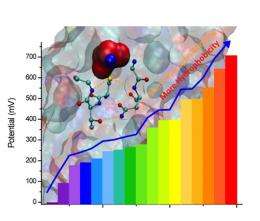Mimicking nature, scientists can now extend redox potentials

(PhysOrg.com) -- New insight into how nature handles some fundamental processes is guiding researchers in the design of tailor-made proteins for applications such as artificial photosynthetic centers, long-range electron transfers, and fuel-cell catalysts for energy conversion.
From rusting iron to forest fires to the beating of a human heart, oxidation-reduction reactions, which transfer electrons from one atom to another, are at the heart of many chemical and biological processes. Each process requires a particular redox potential, just as different electronic devices can require their own special battery.
How nature fine-tunes these potentials over a broad range with little change to the protein's electron-transfer properties or efficiency has largely remained a mystery.
Now, a team led by University of Illinois chemistry professor Yi Lu has unearthed nature's secret, and has utilized it to their advantage. The researchers describe their work in a paper to appear in the Nov. 5 issue of the journal Nature.
"We show that two important interactions, hydrophobicity (water repelling) and hydrogen bonding, are capable of fine-tuning the reduction potential of a particular class of copper-containing proteins called cupredoxins," Lu said. "We extended the range both above and below what had previously been found in nature."
Lu, graduate student and lead author Nicholas M. Marshall, and their collaborators also show that the effects of hydrophobicity and hydrogen bonding are additive, which offers additional control and extends the range of redox (short for oxidation-reduction reaction) potentials beyond what nature, by itself, provides.
Previously, to cover a wide potential range, scientists had to use several different redox agents in conjunction. This made it difficult, if not impossible, to tune the redox potentials without changing other electron transfer properties or the efficiency.
Also, stable, water-soluble redox agents are rare, Lu said, and those that are available have a limited potential range. "Consequently, there is a huge demand for efficient, water-soluble redox agents with a wide potential range for environmentally friendly aqueous or biochemical studies," he said.
To unlock nature's secret, Lu's team studied the behavior of the cupredoxin, azurin. Cupredoxins are redox-active copper proteins that play crucial roles in many important processes, such as photosynthesis and cell signaling. Cupredoxins use a single redox-active center, whose reduction potential is tunable without compromising the structure and electron transfer properties of the protein.
The researchers found that two interactions - hydrophobicity and hydrogen bonding - can selectively raise or lower azurin's redox potential. The interactions occur not in the metalloprotein's innermost, primary core, but in a secondary sphere that surrounds the primary core.
Increasing the hydrophobicity in the secondary sphere can significantly increase the redox potential, the researchers report. The more this secondary region repels water, the more the overall charge on the copper ion becomes destabilized and the higher the potential becomes.
The effect of the hydrogen bonding interaction is subtler than the effect of hydrophobicity, Lu said. Hydrogen bonding can either increase or decrease electron densities around a residue that binds the copper ion in azurin, making the copper ion either easier or harder to reduce and thus slightly changing the redox potential.
"This was nature's secret," Lu said. "That by adjusting the hydrophobicity and the hydrogen bonding, we can raise or lower the redox potential, without changing the protein's electron-transfer properties or decreasing the protein's efficiency."
The result is a tailor-made redox agent that can be set with a very high potential, a very low potential, or with a potential somewhere in between.
"This unprecedented level of control over an electron-transfer protein was achieved by mapping out the major interactions," Lu said, "an approach that may apply to other redox proteins of interest, as well."
Source: University of Illinois at Urbana-Champaign (news : web)

















